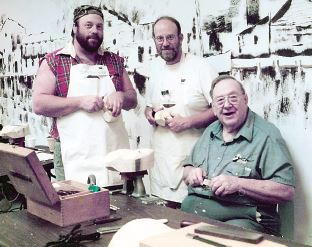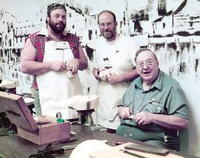All in the Family
Rich and Ross Smoker have more than just carving to tie them together.

Ross and Rich and their father, Dick Smoker, carve together at a class Rich was teaching.
Ask Rich and Ross Smoker about their carving careers, and each will start at the same place: their dad, Dick Smoker. Dick taught high school industrial arts in Selinsgrove, Pennsylvania, for 36 years before he retired in 1982. As part of his curriculum, Dick eventually required his students to learn the basics of carving. Each student had to produce a final project of a finished carving of a shorebird, dog, or other animal from Dick's list of suggestions. (Ross remembers carving a bluegill when he took his Dad's wood shop course in the 1970s.) After Dick retired he and his wife, Connie, began producing items in their home workshop for local manufacturer Pennsylvania House Furniture. He added a shop in the two-car garage below the house where he could carve, and he and Connie could make and paint a variety of decorative wooden accessories.
One Saturday in the early 1970s, Rich and his parents went down to Salisbury, Maryland, to check out the Ward Foundation show.
"It was in the old convention center," Rich remembers. "I saw exactly what I wanted to do for the rest of my life when I walked into that show."
Both Rich, who was carving only hunting decoys, and his dad, who was doing some miniature birds and decoys, caught the bug. While Dick didn't compete very much, he and his family did visit shows in Clayton, New York; Chincoteague, Virginia; Easton, Maryland; and Virginia Beach, Virginia. They enjoyed seeing the work of other carvers and sharing techniques and ideas with the people they met.
Ross carved very little in high school because he became busy with school activities and sports, especially football. After high school, he entered Penn State University ("More like state pen," says Rich) and studied turf grass management. He then worked as golf course grounds superintendent for 13 years. For the past 19 years, he has worked at the Allenwood Low Security Federal Prison as the foreman of a wood shop that makes high-quality furniture. The shop is part of the Federal Prison Industries (Unicore) program that provides practical training and experience for inmates.
Both Smoker brothers use wood as the medium of choice for their career and livelihood. They launched their carving careers with decoys for their own use and later began making decoys for other hunters. Although the brothers grew from a common base, they developed their own innate skills and artistic tastes. Rich turned to carving as a livelihood, and hunters and collectors buy both his decoys and unique decoratives. Ross, on the other hand, has never depended on carving to put food on the table. His work, like that of his dad, remained a sideline but much more than a hobby.
Ross began carving seriously during his college and early working years. While his father was interested mostly in carving shorebirds, Ross says the family's interest in decoys began in the late 1960s when older brother Rich wanted to make a hunting rig. That rig started the brothers on a life's work of carving waterfowl, mostly as decoys, but branching out as well to decorative work as their interests changed.
Ross, who still lives in Selinsgrove and carves in his dad's shop, says he now hunts mostly from a boat blind. He carves rigs for hunters and enjoys dabbling with decorative pieces he gives as gifts to family and friends. While he's not interested in competing aggressively, he does send a few mail-ins each year to support regional shows, and he competes at the World Championships in Ocean City, Maryland, every April. Tuesday and Thursday evenings are "shop night" at the Smoker wood shop. Local carvers gather to work on their own projects as Ross offers guidance and helpful suggestions gained from years of experience. He enjoys teaching and conducts seminars and classes whenever he's asked.
Rich, by contrast, now lives on Maryland's Eastern Shore. He spent 18 years working as an accomplished taxidermist but grew tired of it. For one thing, he liked to do complex habitats with his mounts, which was not the fashion in taxidermy at the time.
"I really got tired of people not appreciating it," he says. For another, Rich says, "I got tired of hearing the hunting stories."
He decided to leave taxidermy behind and try carving full time.
"It's something I have to do," he says. "If I wasn't able to do it I think I would die. Plain and simple."
His shop, nestled on the shore of the Annemessex River at Marion Station, Maryland, is filled with a vast collection of native and exotic mounts and study skins. His taxidermy background gives him unique insight into the anatomy and positioning of his carvings. He's also an avid birder with years of observing species in the wild and loves to shoot sporting clays.
For the past 25 years, Rich has been an exhibitor at the Waterfowl Festival, the November event that takes place annually in Easton, Maryland. He has served on the festival's carvers committee as secretary for 22 years, and the festival inducted him into its hall of fame in 2001. Rich estimates that he has won well over 500 ribbons from various competitions and has more than 70 best of show awards. He's proud of his wins at Ward World Championships: Third in World in 2001 with a long-eared owl and Best in World shootin rig in 2008 with two red-breasted mergansers and a red-throated loon. He's even more proud of all the work he's done for the Ward Foundation, including serving on the board and launching its annual Chesapeake Challenge.
Rich is also producing a series of models that retailer Flambeau Outdoors will use to cast a new line of Canada goose decoys. The line will feature a field shell, six bodies, and 12 heads. The company has the line in production now and will release it soon.
Dick Smoker died in 1999. There's no record of how many of his students followed careers influenced by his industrial arts course, but there's no doubt his legacy lives on in his family. Rich and Ross's three sisters have all tried their hand at carving and painting, as has a nephew in Selinsgrove. A great-nephew is now competing as a junior carver at World and Rich's daughter won the Danner Frazer award at the Ward one year. But there have to be limits.
"My wife doesnt carve," Rich says. "We have an agreement here. I don't play with her computers and she doesnt play with my knives."
Blood is thicker than wood: "The best thing about Ross and me is our bond together," Rich says. "We are brothers, were ten years apart, but each of us looks forward to seeing the other and hunting, fishing, carving—no matter what we do, it's a high point."
Rich and Ross take an obvious delight from teaching what they've learned to other carvers, whether they're teaching at the Worlds or chatting in a weekly shop night. And they do it with an easy style, comic rapport, and rich and self-deprecating humor that puts all listeners at ease.
"When we get together we act like fools and have a good time because we're not going to grow up," says Rich. "Growing up is just out of the question. It's just beyond us to not give each other a hard time."
Their experience, confidence, and obvious love of what they do make them excellent teachers and unexcelled spokesmen for the art of wildfowl carving.
The family ties remain important. Rich explains how he started his 2008 World rig while his mother was in her final illness, working at it back in Selinsgrove during the week and finishing it after her death.
"It sounds strange, but I do think my mom guided me through the whole thing," he says. "When I won it was another milestone for my family. I wish mom and dad were both there to see that."
Rich says he believes his parents had two goals for their children: that they would be gainfully employed and not a bunch of idiots. And then, in typical Rich Smoker fashion, he adds, at least they're gainfully employed.
This article is from the Fall 2010 issue. For more information on our issues, check out our issues page.
Read NextHannah's Setting Sun



